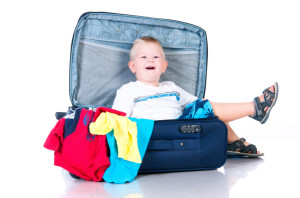 We’re heading off for a European sabbatical soon, and we know from previous trips that dragging along a lot of luggage is a bad idea. If you’ve ever tried to roll a heavy bag down a cobbled street, or had to haul it up five flights of stairs because your quaint rented flat had no elevator, then you understand.
We’re heading off for a European sabbatical soon, and we know from previous trips that dragging along a lot of luggage is a bad idea. If you’ve ever tried to roll a heavy bag down a cobbled street, or had to haul it up five flights of stairs because your quaint rented flat had no elevator, then you understand.
But we’re going to be gone for nine weeks, exploring cities, beaches, caves and countryside. Packing just shorts and flip flops isn’t an option.
Getting everything I think I need into a carry-on has been an interesting challenge. It’s kind of like writing blog posts and 400-word columns for Bankrate and DailyWorth after having written mountains of 1,800-word pieces for MSN. You lay it all out, and then you edit, edit, and edit again. And then maybe you sit on it and squish.
Here’s some of the best advice I’ve found about packing light:
It’s worth it. No checked-bag fees, no long waits at baggage carousels, no lost luggage. The time, money and back strain saved are all well worth the effort of figuring out what to leave behind.
Everything should go with everything. So far, I’ve got the wardrobe down to one pair each of khakis, capris and shorts, in addition to the jeans I’ll wear on the plane. Five tops, two jackets, one sweater and one lightweight dress, plus a scarf or two, will allow me to create about 25 different outfits.
Think double-duty. My lightweight robe works as a swimsuit cover-up. My sandals work at the beach or a nice restaurant. My running shoes are low-key enough to work as casual dress shoes. Speaking of shoes:
Ease up on the footwear. They take up huge amounts of space. I’m trying to limit mine to the sneakers, a pair of black leather walking shoes and the flat-soled sandals.
Don’t bring what you’ll find there. I’m skipping most toiletries and hair appliances (which need adapters and converters to work over there, anyway). The hotels will have what we need and if they don’t, there will be shops.
Embrace digital. Not too long ago, every trip with the kiddo would mean packing a DVD player and DVDs along with books and games. I’d have a stack of novels and guidebooks. Hubby would bring much of the New York Times bestseller list. Now it’s all in our iPads.
If you’ve traveled long and light, I’d love to hear your trips for what to bring—and what not to bring.
UPDATE: We left for Europe with three carryons–and came back with two of them, plus two larger pieces of luggage. (One of the carryons, stuffed full of purchases, went home early with our niece.) My hubby’s penchant for buying big heavy art books, my daughter’s love of souvenirs and my flea-shopping habit quickly doomed the idea of traveling that light.
We should have consulted Will’s aunt, a retired travel writer, who roams the world with a medium-sized spinner. It’s big enough to bring what she needs but small enough for her to handle it without help.




